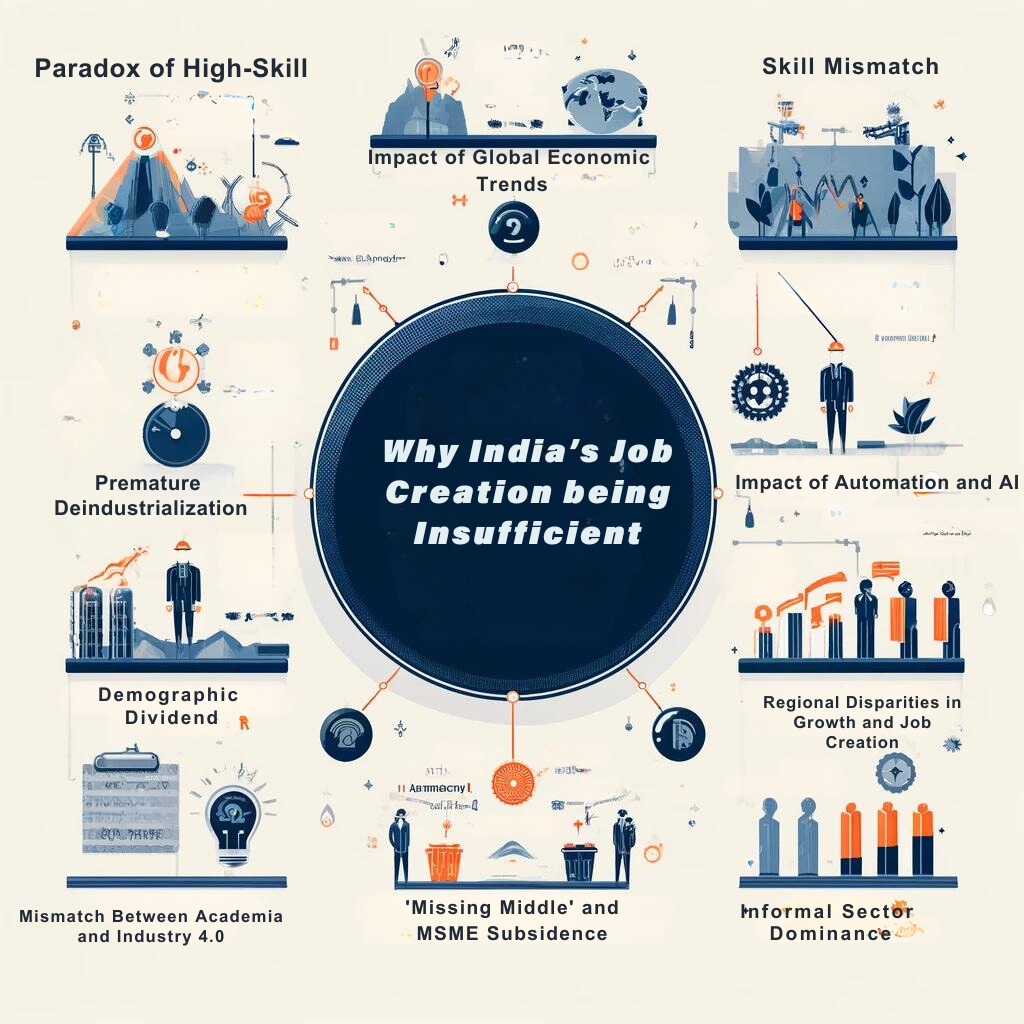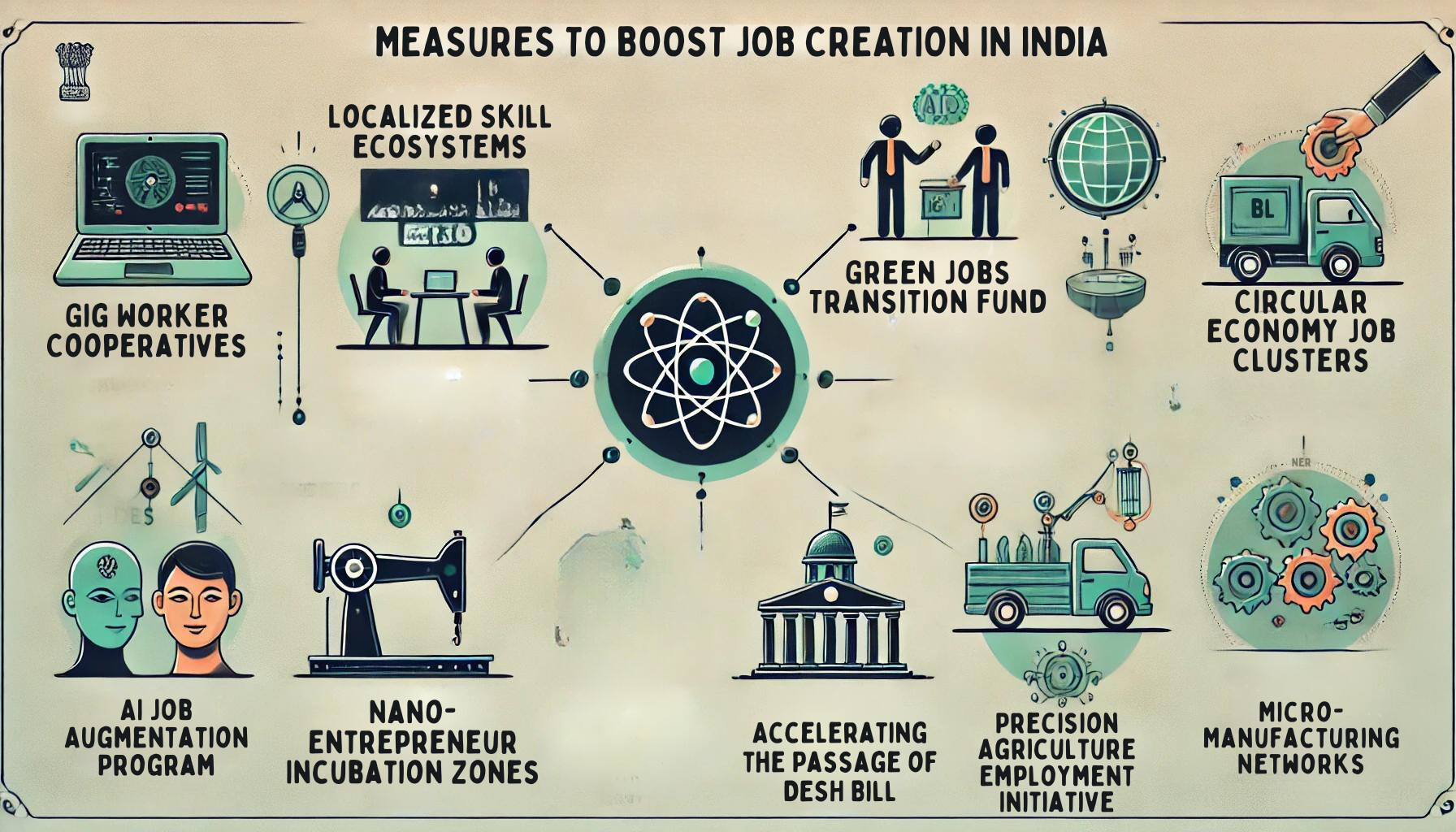India’s urban landscape is filled with ambitious young graduates seeking better lives. However, their dreams often clash with the harsh reality of urban unemployment. Despite economic growth, job creation has not kept pace, especially for the young population. The need to create a future-proof workforce capable of navigating the evolving economy is crucial for ensuring that India’s cities remain hubs of growth and opportunity.
Origin of the Article
This editorial is based on “Welfarism is not the solution for India’s job problem, skill creation is” which was published in The Indian Express on July 9, 2024. The article highlights the urgent need to address India’s unemployment crisis by emphasizing vocational training, wage subsidies, and basic income supplements.
Relevancy for UPSC Students
Understanding the dynamics of job creation is essential for UPSC aspirants, as it ties directly to the Indian Economy segment of the syllabus. Knowledge of government policies, economic trends, and skill development programs can aid in answering questions on employment, economic growth, and social justice. This topic also helps develop analytical skills needed for essay writing and policy analysis.

Why in News
The topic of India’s jobless growth is crucial for UPSC aspirants as it addresses a persistent national challenge that intertwines with economic development, skill gaps, and government interventions. This issue has been a focal point in previous UPSC exams, such as the 2015 question on jobless growth and the 2023 question on structural unemployment. Understanding these dynamics helps aspirants critically analyze India’s economic policies and their socio-economic impacts.
Breaking India’s Jobless Growth Trap
India’s urban landscape is a canvas of ambition. Modern metropolises pulsate with economic activity, attracting a steady stream of young graduates seeking their fortunes. For countless young Indians, the city lights represent a beacon of opportunity. They arrive with dreams of a better life, fueled by years of education and ambition. However, these dreams are increasingly deferred by the harsh reality of urban unemployment. India faces the critical challenge of creating good-quality jobs, especially for its young population. This issue has persisted across decades, with economic growth failing to keep pace with job creation. India needs to shift focus on creating a future-proof workforce equipped to navigate the demands of the evolving Indian economy. By addressing this challenge head-on, India can ensure its cities remain engines of growth and opportunity for all.
Why Is India’s Economic Growth Not Corresponding with Sufficient Job Creation?

Paradox of High-Skill, Low-Employment Sectors
India’s economic growth has been predominantly driven by services and capital-intensive manufacturing sectors, which typically generate fewer jobs relative to their economic output. The IT sector, for instance, contributes significantly to GDP but employs only about 4.5 million people directly. This trend is further exemplified by the recent push for advanced manufacturing, such as in semiconductors and electronics. While these industries boost economic indicators, they often fall short in creating large-scale employment opportunities. Particularly for the less skilled workforce.
Premature Deindustrialization and Its Impact
India is experiencing premature deindustrialization, where the share of manufacturing in both GDP and employment begins to decline at a much lower level of per capita income compared to developed countries. This trend, partly driven by global competition and automation, limits the ability of the manufacturing sector to absorb surplus labor from agriculture, traditionally a key pathway for job creation in developing economies.
Impact of Global Economic Trends
India’s job market is increasingly influenced by global economic trends. Protectionist policies in developed economies have affected India’s export-oriented industries, impacting job creation in these sectors. Moreover, global supply chain disruptions and economic recessions, such as the loss of over 4.25 lakh tech jobs in 2023, have highlighted vulnerabilities in certain industries and their employment potential.
Skill Mismatch
The rapid pace of technological change has created a significant gap between the skills demanded by the job market and those possessed by the workforce. The 2015 Report on National Policy on Skill Development and Entrepreneurship estimated that only 4.7% of the total workforce in India had undergone formal skill training, highlighting a severe shortage of job-ready skills. Recent initiatives like Skill India, while ambitious, have struggled to meet targets and ensure successful job placements. This mismatch not only leads to unemployment but also underemployment, where individuals work in roles below their qualification level or potential.
Informal Sector Dominance
Over 90% of India’s workforce is employed in the informal sector, characterized by lower productivity, limited job security, and minimal social protection. This prevalence of informal work not only affects job quality and worker welfare but also hampers overall economic productivity and the ability to create sustainable, high-quality jobs. The gig economy and platform-based work have created new employment opportunities but also introduced job market precarity. These platforms offer flexible work but often lack job security, benefits, and career growth prospects.
Demographic Dividend Challenge
India adds approximately 12 million people to its workforce annually, creating immense pressure on job creation. To absorb these new entrants and address existing unemployment, the economy needs to generate 10-12 million jobs per year. However, job creation has consistently fallen short of this target. This failure to harness the demographic dividend risks turning it into a demographic burden, potentially leading to social unrest and economic instability.
‘Missing Middle’ and MSME Subsidence
India’s industrial landscape is marked by a predominance of very small firms (with less than 50 workers) and a few very large corporations, with a conspicuous absence of mid-sized firms. This ‘missing middle’ phenomenon hampers job creation, as mid-sized firms typically have the highest potential for employment generation and scaling up. The lack of adequate growth from small to medium enterprises stunts overall job creation in the formal sector. Also, the MSME sector, initially hit by demonetization and further exacerbated by the COVID-19 pandemic, continues to struggle in its recovery efforts, hampering job growth.
Impact of Automation and AI
Emerging technologies, particularly automation and artificial intelligence, are reshaping the job landscape across sectors. The McKinsey Global Institute estimates that 9% of India’s workforce could be displaced by automation by 2030. While these technologies create new job roles, they often require high skill levels, potentially exacerbating unemployment among less skilled workers.
Mismatch Between Academia and Industry 4.0
India’s traditional education system often fails to equip students with the critical thinking and practical skills required in the modern job market. The India Skills Report found that only 47% of Indian graduates were employable in 2019, highlighting a significant gap between academic qualifications and job readiness. This mismatch not only leads to unemployment among graduates but also creates inefficiencies in the labor market, where companies struggle to find suitable candidates despite a large pool of job seekers.
Regional Disparities in Growth and Job Creation
Economic growth and job opportunities in India are heavily concentrated in a few urban centers, leading to significant regional imbalances. This concentration creates migration pressures, with workers moving from less developed regions to urban areas in search of employment.
Major Government Initiatives to Bridge the Employment Gap
The Indian government has launched several initiatives aimed at addressing the employment gap. These policies focus on skill development, incentivizing job creation, promoting entrepreneurship, and formalizing the informal sector.
Skill Development and Training Programs
The Skill India Mission, launched in 2015, aims to train millions of youth in industry-relevant skills through schemes like Pradhan Mantri Kaushal Vikas Yojana (PMKVY) and the National Skill Development Corporation (NSDC). Additionally, the Apprentice Protsahan Yojana (APY) incentivizes companies to hire apprentices, providing on-the-job training and experience for young individuals.
Incentivizing Job Creation
The Aatmanirbhar Bharat Rojgar Yojana (ABRY) was introduced during the pandemic to provide wage subsidies to employers who create new jobs and retain existing ones. Production Linked Incentive (PLI) schemes offer financial incentives to companies in specific sectors, such as electronics and automobiles, to boost domestic manufacturing and create jobs.
Fostering Entrepreneurship and Self-Employment
Pradhan Mantri Mudra Yojana (PMMY) provides microloans to aspiring entrepreneurs for starting or expanding small businesses. Stand-Up India aims to promote entrepreneurship among women and Scheduled Castes/Scheduled Tribes by facilitating bank loans.
Addressing the Informal Sector
The e-SHRAM Portal is an online platform aimed at registering informal workers, improving their access to social security benefits and potentially formalizing their employment.
State-Specific Initiatives
States like Rajasthan have launched specific job creation programs, such as the Indira Gandhi Urban Employment Guarantee Scheme, to tackle regional employment challenges.
PESTEL Analysis
| Political: Government initiatives like the Skill India Mission and Aatmanirbhar Bharat Rojgar Yojana aim to enhance skill development and job creation. However, policy implementation and political stability are crucial for these initiatives’ success. Economic: Despite economic growth, sectors like IT and advanced manufacturing do not generate sufficient employment. Premature deindustrialization, a significant skill mismatch, and a dominant informal sector hamper job creation. Economic policies need to focus on sustainable employment growth. Social: The high rate of unemployment, especially among youth, and regional disparities in job opportunities exacerbate social tensions. Enhancing education and aligning it with market needs are essential to addressing the social implications of jobless growth. Technological: Automation and AI are poised to displace many low-skill jobs by 2030. Embracing technology while simultaneously investing in AI job augmentation programs and green jobs can help mitigate the adverse effects. Environmental: The transition to a green economy offers new employment opportunities. Initiatives like the Green Jobs Transition Fund can support workers moving from carbon-intensive industries to sustainable practices. Legal: The government’s focus on formalizing the informal sector through the e-SHRAM Portal and creating a flexible investment framework, like accelerating the DESH Bill passage, is aimed at improving job security and attracting investments for job creation. |
Measures to Boost Job Creation in India
To ensure sustainable job creation, India needs to adopt long-term policies that address the various dimensions of employment challenges. These measures should focus on localized skill development, green jobs, gig economy support, AI integration, and more.

Localized Skill Ecosystems
Creating micro-level skill development hubs aligned with local industry needs can ensure a direct pipeline of skilled workers to local employers. These hubs would offer tailored training programs based on the specific requirements of industries in each region.
Green Jobs Transition Fund
Establishing a dedicated fund to support workers transitioning from carbon-intensive industries to green jobs is essential. This fund would provide retraining, relocation assistance, and temporary income support, facilitating a smoother shift towards a sustainable economy while minimizing unemployment.
Gig Worker Cooperatives
Promoting the formation of worker-owned cooperatives in the gig economy can provide gig workers with better bargaining power, shared resources, and a safety net, while still maintaining the flexibility of gig work.
AI Job Augmentation Program
Implementing a national program to train workers in AI-assisted job roles can create new job categories that combine human skills with AI capabilities. This initiative would focus on increasing overall productivity and employment.
Circular Economy Job Clusters
Developing specialized industrial clusters focused on circular economy principles can create jobs in recycling, upcycling, and sustainable product design, fostering a new sector of employment while addressing environmental concerns.
Micro-Manufacturing Networks
Encouraging the creation of decentralized, small-scale manufacturing units connected through digital platforms can reduce the need for large factories while creating jobs in smaller towns and rural areas. This network can be led by MSMEs through credit guarantee schemes.
Nano-Entrepreneur Incubation Zones
Establishing specialized zones in tier-2 and tier-3 cities focused on nurturing ultra-small businesses can provide shared resources, mentorship, and market linkages for entrepreneurs. These zones would target rapid scaling from 10–15 employees to 40–50 employees within 1-2 years.
Precision Agriculture Employment Initiative
Launching a nationwide program to train and employ youth in high-tech, precision agriculture techniques can create a new category of tech-savvy agricultural professionals. This would include drone operations for crop monitoring, data analytics for yield optimization, and IoT-based farm management.
Accelerating the Passage of DESH Bill
Accelerating the passage of the DESH Bill, which replaces the Special Economic Zones Act, can create a flexible framework for attracting investments and generating employment. It facilitates the development of specialized hubs based on regional strengths and enables partnerships with economically similar cities abroad, fostering international economic cooperation, skill development, technology transfer, and market access.
Conclusion
In conclusion, addressing India’s job creation challenge requires a multi-faceted approach that combines skill development, innovative employment policies, and sector-specific initiatives. By fostering a future-ready workforce and promoting inclusive growth, India can transform its demographic dividend into an economic powerhouse. UPSC aspirants must keenly understand these dynamics to contribute effectively to policy formulation and nation-building.
| UPSC Civil Services Examination, Previous Year Questions (PYQs) Mains Q. The nature of economic growth in India in recent times is often described as jobless growth. Do you agree with this view? Give arguments in favour of your answer. (GS Paper III, 2015). Q. “Success of ‘Make in India’ programme depends on the success of ‘Skill India’ programme and radical labour reforms.” Discuss with logical arguments. (GS Paper III, 2015). |


